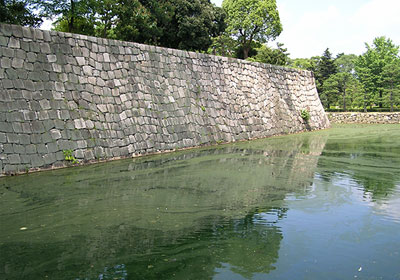|
||
 |
||

Nijyoujyou 二条城 (Kyoto)
(C)2001 Japanese Architecture and Art Net Users System. No reproduction or republication without written permission.
掲載のテキスト・写真・イラストなど、全てのコンテンツの無断複製・転載を禁じます。
|
||||||
| hori 堀 | ||||||
| KEY WORD : architecture / castles | ||||||
| A moat that completely or partially surrounds a castle, palace, or mansion. Moats are primarily for protection but may divide one part of a complex from another as well. The two main classifications of moats are water-filled moats *mizuhori 水堀, excavated in flatland areas; and dry moats *karabori 空堀, dug in mountainous areas. The water in a moat could be flowing or still; deep water with a thick muddy bottom was considered the most effective. The effectiveness of a dry moat depended on its depth, the angle of its banks, and the irregularities, such as furrows or ridges at the bottom. Typically a moat was associated with an adjoining earthen embankment *doi 土居. A moat's depth and width was usually determined by the castle's scale and by the site's topographical and geological characteristics. The various early modern schools of military strategy set forth specific ideals in this respect. Wet and dry moats alike may be classified by the shape of their vertical sections: box-shaped moat hakobori 箱堀, mortar shaped moat *yagenbori 薬研堀, lopsided mortar shaped moat, katayagenbori 片薬研堀, tweezers or U-shaped moat kenukibori 毛抜堀. | ||||||
 Nijyoujyou 二条城 (Kyoto)
|
||||||
| REFERENCES: | ||||||
| EXTERNAL LINKS: | ||||||
| NOTES: | ||||||
(C)2001 Japanese Architecture and Art Net Users System. No reproduction or republication without written permission. 掲載のテキスト・写真・イラストなど、全てのコンテンツの無断複製・転載を禁じます。 |
||||||